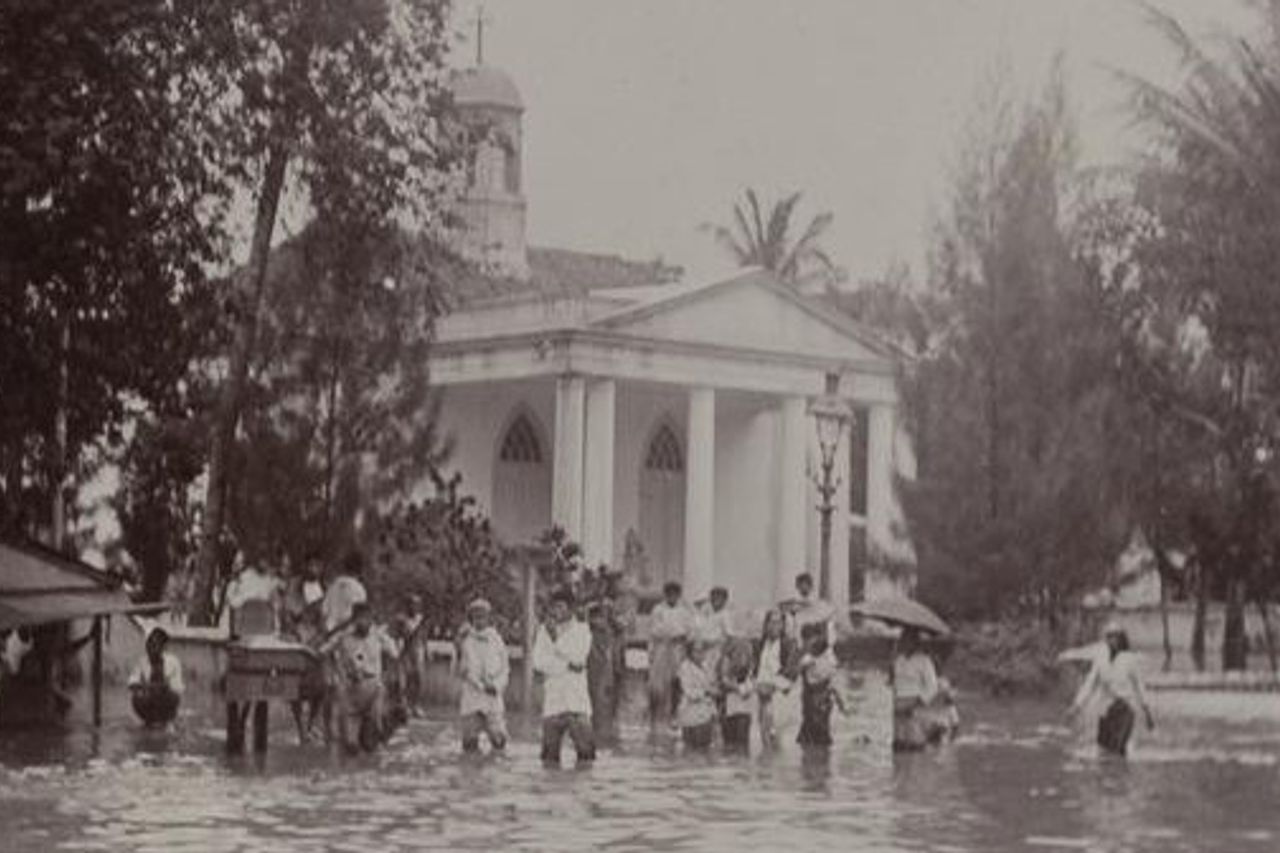National Palace Flooded Since The Dutch Era

JAKARTA - The rain in Jakarta that flushed since Tuesday, February 25, early morning until morning, caused a number of areas in Jakarta to be inundated. The Merdeka Palace was inundated by water. However, within a few hours, the water receded immediately.
In fact, this ring one area is not the first time that river overflows have been exposed. This has been legendary since the time of the Dutch East Indies government.
1932 In early January 1932, in Batavia --Jakarta today - it rained hard for days. The rain caused floods that inundated the majority of Batavia. The flash flood even hit the Merdeka Palace or at that time it was called the Palace of the Governor-General Koningsplein.
The inhabitants of Batavia, said historian JJ Rizal in his writing in Tempo, January 27, 2013 edition, still saw the flood as more occult. The name Nyai Roro Kidul was widely mentioned when the flood came. The people at that time considered the flood to be anger and at the same time a warning for the people to look after Sukarno, who at that time happened to have just been released from Sukamiskin prison.
However, member of the Batavia City Council in 1919, MH Thamrin, considered the situation unfavorable to him. His efforts with Herman van Breen in building awareness that flooding is not a destiny that cannot be found a solution, is threatened in vain. They surrendered to accept the flood as reasonableness while associating the incident with myths.
Floods have been an annual problem since the days of the Dutch government. In 1923 Breen had actually proposed to build a West Flood Canal, but it was ignored. In line with that, the problem of causing flooding in the upstream area also continues to increase with ongoing deforestation in the mountains of West Java in the north of central part.
As a result, the flow and flow of Ciliwung experiences changes and disruptions. The rivers have become shallow and the sedimentation in the Batavia waterways has caused troublesome and costly maintenance.
After independence, under the rule of Sukarno who was an architect, ideas to alleviate the flood problem were still not the main focus of the government. The mayor of Jakarta for the period 1953-1958 Sudiro stated "There was no money to deal with the floods."
Sukarno only moved after the severe Jakarta floods occurred in 1960 and 1963. Two years after that, Sukarno issued a decision from the Flood Prevention Project Command (Kopro Banjir). To make this happen, the Jakarta City Government issued the 1965-1985 Master Plan for Flood Control.
1970 The plans carried out by Sukarno seemed unable to eliminate the problem of flooding. In 1970 a big flood occurred again. The flood at that time, according to Restu Gunawan in the Failure of the Canal System (2010), inundated important areas adjacent to the Palace.
"Electricity throughout the city was cut off due to massive floods. Stagnant water as high as 20 centimeters to 2 meters," wrote Gunawan. As a result, the electricity was cut off and 43 hospital patients were evacuated.
Because at that time almost the entire Monas area was also flooded, the second President of the Republic of Indonesia Soeharto conducted a helicopter survey of the flooded areas.
2002 Large floods targeting the Merdeka Palace continue until the reform era. The February 2002 flood inundated the Merdeka Palace area.
According to the Former Head of the BNPB Center for Data, Information and Public Relations Sutopo Purwo Nugroho in his article entitled Evaluation and Analysis of Rainfall as a Cause Factor for the Jakarta Flood Disaster (2002), the rainfall that occurred from January 26 to February 1 2002 caused an overflow. rivers and drainage channels. So that it invites a big flood.
The flood that occurred during the leadership of Governor Sutiyoso (1997-2007 period) inundated 42 sub-districts in Jakarta with 168 sub-districts or 63.4 percent of all urban villages in Jakarta. The inundation area reaches 16,041 hectares or 24.25 percent of the area of DKI Jakarta. The flood height at that time reached 5 meters.
Many people blame the cause of the disaster because of the high rainfall in the Bogor and Jakarta areas. According to Sutopo, apart from the rainfall, "the flooding was also supported by the existence of a water resource management system, especially surface water, which was not good, so that the ability of drainage channels and flood control was not able to regulate surface runoff resulting in flooding."
2014 and 2016 The problem of flooding seems to have never neglected Jakarta. Until the era of the leadership of DKI Jakarta Governor Joko Widodo (Jokowi), flooding was still a classic problem that was difficult to overcome.
Quoting the 6 February 2014 edition of the Tempo newspaper, the culverts on Jalan Medan Merdeka overflowed due to the high intensity of rain at that time. Jokowi stated that the flooding around the State Palace was more due to the high intensity of rainfall which had fallen since the day before the incident.
Deputy Governor of DKI Basuki Tjahaja Purnama said that flooding around the Palace area should not have occurred. According to him, the inundation that occurs is caused by the accumulation of garbage in each culvert.
"It should not be possible, because the water level at the gates is low," said Ahok.
In the following years, namely 2015 to 2016, similar problems still occurred. In the rainy season, water again surrounds the Merdeka Palace area.
